A lot of businesses are obsessed with trying to go viral.
Not in a “dancing on TikTok” way, but they have the need to grow their audience fast.
If you can relate, then you are probably mostly asking, “Why do some ideas take off while others crash, even if they’re good?”
That’s what The Tipping Point by Malcolm Gladwell would help you solve. It’s a brilliant book in the business and psychology genre. It would give more answers than you even thought you needed.
He explains that ideas, trends, and behaviours spread like viruses. And just like an outbreak, it only takes the right push to hit that tipping point when growth becomes unstoppable.
You’ll love this book if you’re trying to start an online business, build a product, or simply want your content to reach more people. It breaks down how things go viral, why some people are more influential than others, and what little changes can make a big impact.
Let’s explore 9 smart takeaways.
Table of Contents
Detailed Summary of The Tipping Point by Malcolm Gladwell
“Why does one idea go viral and others don’t?”
That’s the question The Tipping Point by Malcolm Gladwell tries to answer. It’s a business and psychology book that breaks down why some products, trends, or behaviors suddenly explode and spread fast. He says that tipping points don’t happen by accident. There’s always a pattern behind the momentum.
He explains three core ideas:
- The Law of the Few
Some people have more influence than others. He calls them connectors, mavens, and salespeople. Connectors know everyone and spread ideas across different groups. Mavens love to research and share useful info. Salespeople know how to persuade and move people to action. - The Stickiness Factor
This is what makes an idea memorable. It could be a catchy phrase, an unforgettable ad, or even a small change in how something is presented. It’s not just about being loud. It’s about being sticky. - The Power of Context
Your environment plays a huge role in how things spread. Timing, setting, even small changes in surroundings can impact how people respond.
If you’re building a brand, trying to grow an online business, or struggling to get attention, this book gives you a framework. It helps you stop guessing and start thinking about how to make your message contagious. You’ll learn how to find the right people, shape your idea, and launch it at the right time.
And that might just be your tipping point.
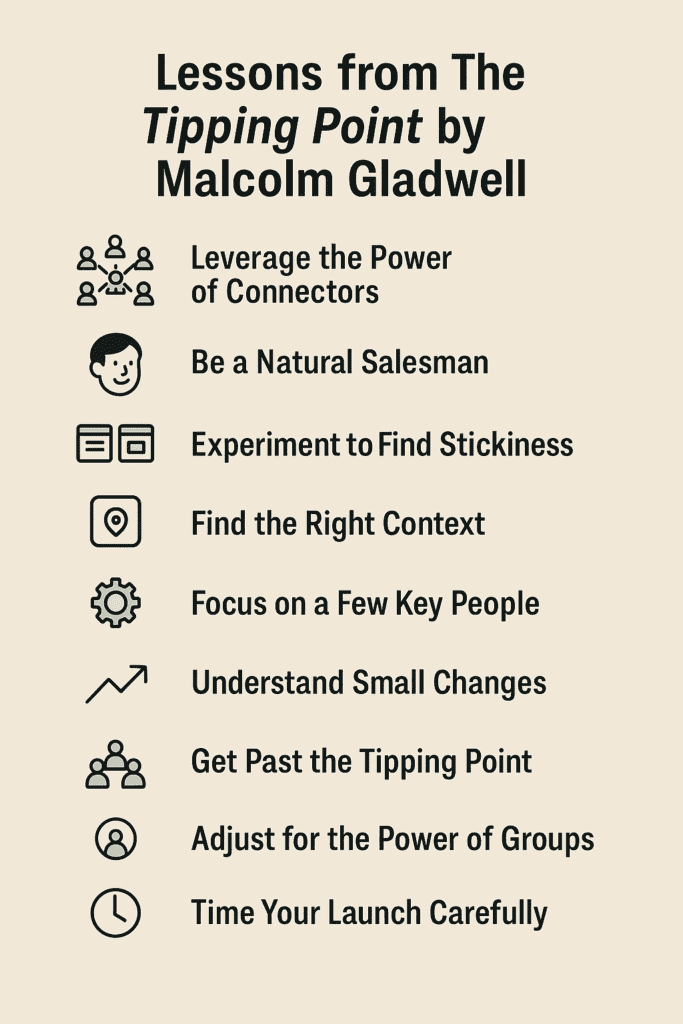
9 Lessons from The Tipping Point by Malcolm Gladwell
“The tipping point is the moment of critical mass, the threshold, the boiling point.” — Malcolm Gladwell
If you’ve ever wondered why some ideas spread like wildfire and others fall flat, this book will make you pause. The Tipping Point by Malcolm Gladwell isn’t just about trends or viral content. It’s about human behavior, influence, and how small things can cause big changes. He breaks down what makes a product, idea, or social movement go from unnoticed to unstoppable. And if you’re trying to start something — a side hustle, content brand, online store — these 9 lessons will give you clarity.
Let’s get into it.
1. A few people have more power than the rest
Gladwell calls this the Law of the Few.
He explains that a small group of people are always behind the success of ideas that go viral. These people fall into three categories:
- Connectors: They know lots of people from different worlds. They introduce, refer, and share.
- Mavens: They know things and love sharing helpful info. You probably go to them for product advice.
- Salespeople: They persuade you without you realizing it. You feel safe around them. You trust them.
You need all three types in your corner. If you’re building something and no one is talking about it, maybe your idea hasn’t hit the right people yet.
2. Connection beats strategy

You can have the smartest plan, but if it’s not shared by the right person, it won’t spread.
Let’s say you’re promoting a new service. You’ve got the branding. You’ve got the copy. But a connector can mention it in a single tweet or WhatsApp group and your growth triples.
Your ideas need people. Not just any people. The right ones.
Start by asking yourself:
- Who is one person that can introduce this to 10 others?
- Who do people go to for product suggestions in your niche?
- Who’s a natural at getting others excited?
3. People listen to those they trust
Mavens don’t just collect info. They give it out freely. And people trust them.
When you’re launching a business, having a maven talk about it is like getting the best kind of marketing. They’ll do the work — compare features, list pros and cons, and genuinely want to help others discover you.
This is a reminder for you to keep things honest and helpful. Mavens won’t promote trash.
4. Selling is more about feeling than logic
Salespeople don’t push. They align.

Gladwell says they’re masters at picking up on emotions. They adjust how they talk, mirror your tone, and make you feel like you’re making the decision — even if they guided you there.
You probably know someone like this. You hang out with them and end up doing something you didn’t plan for, and still feel good about it.
When you’re writing your landing page, creating videos, or selling anything, think like a salesperson:
- Speak simply
- Focus on how it makes the user feel
- Use tone and body language if it’s a video
- Don’t oversell. Show benefits through behavior
5. Stickiness matters more than volume
Here’s the second core idea in the book: the Stickiness Factor.
It’s not about how many people see your content. It’s about how many remember it.
Gladwell gives the example of Sesame Street. Just moving the words behind the Muppets instead of beside them increased children’s focus. No new content. Just better packaging.
This means your business doesn’t need a rebrand or a new offer. Maybe you just need to tweak your wording. Or change your website layout. Or make your call to action more clear.
A small change can flip the switch.
6. Test tiny tweaks often
You won’t know what sticks unless you test it.
Gladwell shares an example of someone lowering an ebook price from $4.99 to $4.98 and getting better results. Just one cent. That’s wild.

If you’re stuck, try small experiments:
- Change your pricing slightly
- Move your CTA button
- Rework your headline
- Shorten your onboarding email
The win is usually hiding in the details.
7. Environment shapes outcome
The final factor in the book is The Power of Context.
People don’t act in a vacuum. They respond to their surroundings. Gladwell shares the Broken Window Theory — if a neighborhood looks neglected, crime increases. If it’s clean and orderly, people behave better.
You can apply this to your own life too.
- Want to focus more? Clean your room.
- Want to start that side hustle? Hang around people building things.
- Want to improve your habits? Change your environment first.
Sometimes the best productivity tool is just silence, structure, or a group chat full of builders.
8. Timing is everything
Even the best idea won’t spread if the context is wrong.
You may have the perfect offer but post it at the wrong time or to the wrong group. No traction. Gladwell’s point is not just that context matters — it’s that it often determines success.
Your message needs to land when your audience is ready.
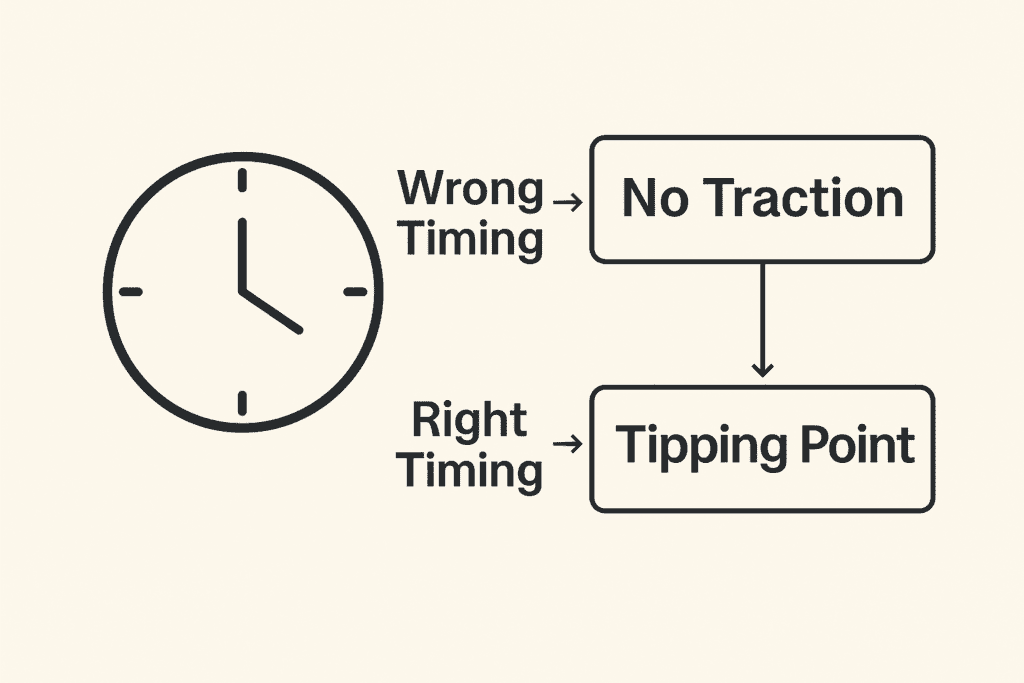
So pay attention to timing.
- What’s going on in your audience’s life?
- Are they distracted or open to something new?
- Are you sending an offer during their paycheck week or in the middle of stress season?
9. Your idea won’t spread itself
The core message of The Tipping Point is that virality is not luck. It’s structure.
You need:
- The right people
- A sticky message
- The right environment
If one is missing, your growth will stall.
This book reminds you that even small creators can create big shifts. If you focus on connection, clarity, and context, you increase your chance of reaching that tipping point, where things take off and don’t slow down.
Gladwell breaks down all these concepts with real examples that help you see what works and why. Grab your copy of The Tipping Point by Malcolm Gladwell and start applying these lessons to your business, brand, or project today.
Conclusion
If you’re serious about building something that spreads, The Tipping Point by Malcolm Gladwell gives you a clear path. You don’t need a huge budget or a massive audience.
You just need the right people, the right message, and the right moment. These lessons aren’t theory. They’re tools you can use to grow your side hustle or online business faster and smarter.
If this helped bring you clarity, you’ll want to read my next post on Traction by Gino Wickman. It breaks down how to manage growth once momentum kicks in. You’ll need both books to build something that lasts.
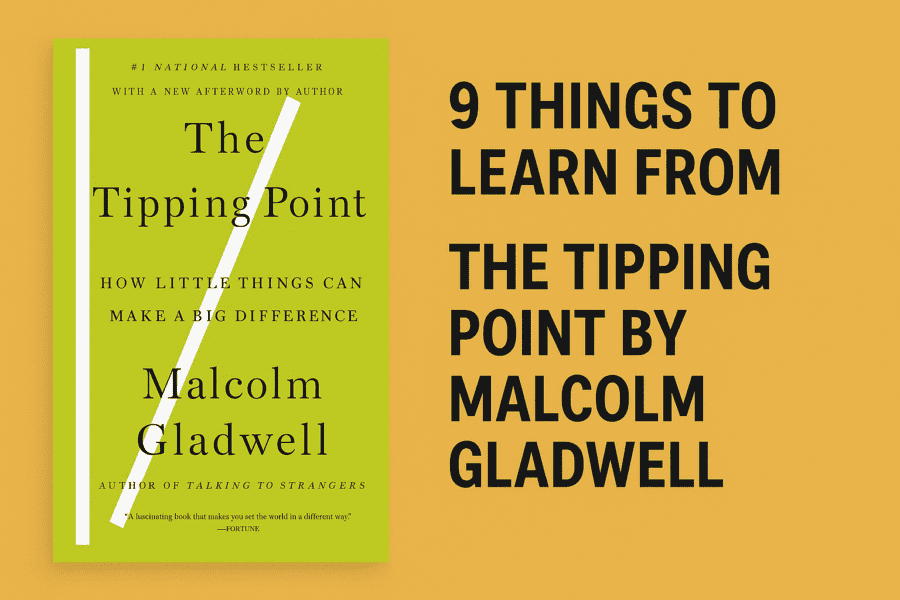
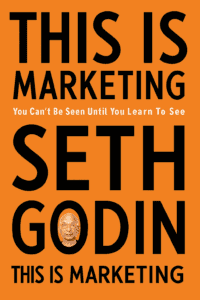

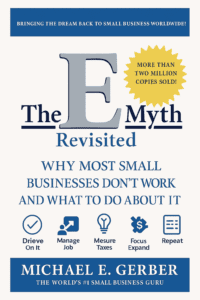
Pingback: Think and Grow Rich by Napoleon Hill (9 Practical Lessons for Building Wealth and Clarity Plus Book Summary)